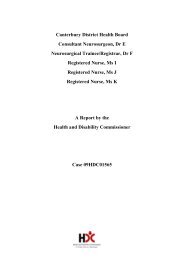Gisborne Hospital Report - Health and Disability Commissioner
Gisborne Hospital Report - Health and Disability Commissioner
Gisborne Hospital Report - Health and Disability Commissioner
Create successful ePaper yourself
Turn your PDF publications into a flip-book with our unique Google optimized e-Paper software.
<strong>Gisborne</strong> <strong>Hospital</strong> 1999 – 2000<br />
Operating Theatre Protocols<br />
only a locum doctor for six months. He was an asset to <strong>Gisborne</strong> <strong>Hospital</strong> <strong>and</strong><br />
I am sorry that this was not always sufficiently appreciated.”<br />
7.8 Straps were discussed at a theatre management committee meeting. Mr<br />
Burton said he was happy to have the straps, as were the other surgeons,<br />
especially for obese patients when tilting for certain surgery. The minutes<br />
record:<br />
“[The Theatre Manager] said the nursing staff were researching policies<br />
on restraining patients. The straps are to go ahead at minimal cost made<br />
by orthotics. [The Group Manager (<strong>Hospital</strong>)] is happy to write a patient<br />
restraint policy for theatre.” (Minutes dated 22 March 2000. This policy<br />
was not produced for the investigation team.)<br />
Dr Lucas’ explanation<br />
7.9 Dr Lucas responded as follows:<br />
“It is common practice to use uterine displacement in a supine woman<br />
being positioned for Caesarean section. This position minimises aortacaval<br />
compression <strong>and</strong> consequent foetal compromise. The<br />
displacement can be achieved by placing a pad under the hip to produce<br />
the requisite 15 degrees of lateral pelvic tilt <strong>and</strong> a corresponding torsion<br />
of the torso which, I believe, contributes to post operative backache. A<br />
superior method in my opinion, is to tilt the whole table 15 degrees.<br />
This causes the mother (both New Zeal<strong>and</strong> <strong>and</strong> Canadian) to feel like<br />
they are going to fall off the table but they are less frightened if they are<br />
pre warned that the table is going to tilt. Feedback I received from Mr<br />
Madden suggested that I was conspicuous compared to my colleagues,<br />
in the length to which I explained things to my patients, obstetrical <strong>and</strong><br />
otherwise. I also tried, against nursing resistance, without much success,<br />
to institute the routine of placing a pillow behind the knees of supine<br />
parturients, also as a method of reducing post operative backache. A<br />
second group of patients, who are tilted even more than in obstetrics, are<br />
the people having laparoscopic cholecystectomies.<br />
In both these groups of patients, or for that matter, in everyone who is<br />
anaesthetised or has anaesthetised legs, it has been my observation that a<br />
wide safety strap is placed across the legs at mid thigh level. This does<br />
not happen at <strong>Gisborne</strong>.”<br />
7.10 When Dr Lucas asked for the straps at <strong>Gisborne</strong> he was told by a nurse that<br />
they were against the hospital policy regarding abusive <strong>and</strong> excessive patient<br />
restraint. Dr Lucas took this issue to the Group Manager (<strong>Hospital</strong>) who<br />
assured him it was not against policy.<br />
Management response<br />
7.11 In the opinion of the Group Manager (<strong>Hospital</strong>):<br />
99
















